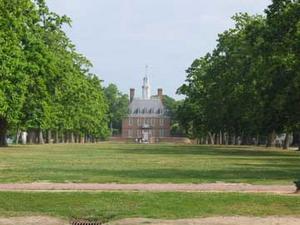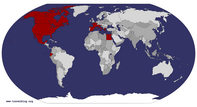Advertisement
Published: March 16th 2009
[youtube=YXwpx2v1V6s]

 Williamsburg
Williamsburg
Williamsburg, Virginia - United States of AmericaSep25, 2005
*
City official name :Williamsburg
*
Founded date : *
Location :Virginia State
*
Elavation :? ft (? m)
*
Area :Approximately ? square miles (? km²).
*
Facts :Williamsburg is a city located on the Virginia Peninsula in the Hampton Roads area of Virginia. As of the 2000 census, the city had a total population of 11,998. It is bordered by James City CountyGR6 and York County, and is an independent city. The Bureau of Economic Analysis combines the city of Williamsburg with James City County for statistical purposes. Williamsburg, in the center of the Historic Triangle of Virginia (which includes Jamestown and Yorktown), is well-known for the restored colonial area of the city, Colonial Williamsburg, and for the College of William and Mary which is situated mostly within the city of Williamsburg. The newspapers of record are the Daily Press, published in Newport News, and the bi-weekly The Virginia Gazette, published in Williamsburg.
The area which became Williamsburg was settled in 1632 and called Middle Plantation. It was so named due to its location on high ground about half-way across the Virginia Peninsula between the James River and York River. A stockade across the peninsula,

 Williamsburg
Williamsburg
Williamsburg, Virginia - United States of Americawhich was about 6 miles wide at that point between College Creek and Queen's Creek (which each fed into one of the two rivers) provided some security from attacks by the Native Americans for colonists farming and fishing lower on the Peninsula from that point.
The area of Middle Plantation was included in James City Shire when it was established 2 years later in 1634, as the Colony reached a total population of approximately 5,000. Jamestown, which had been the original capital of Virginia Colony, remained as such until its burning during the events of Bacon's Rebellion in 1676. Immediately after Governor William Berkeley regained control, temporary quarters for the functions of the seat of government were established about 12 miles away on the high ground at Middle Plantation while the Statehouse at Jamestown was rebuilt. The Burgesses found the surroundings both safer and more pleasant environmentally than Jamestown, which was muggy and plagued with mosquitos.
A school of higher education had long been an aspiration of the colonists. An early attempt at Henricus failed after the Indian Massacre of 1622. The location at the outskirts of the developed part of the colony had left it more vulnerable

 Williamsburg
Williamsburg
Williamsburg, Virginia - United States of Americato the attack. In the 1690s, the colonists tried again and sent Reverend James Blair who spent several years in England lobbying and finally obtained a royal charter for the desired new school, which was named the College of William and Mary in honor of the monarchs of the time. When Reverend Blair returned to Virginia, the new school was founded in a safe place, Middle Plantation in 1693. Classes began in temporary quarters in 1694, and the College Building, a precursor to the Wren Building, was soon under construction.
Four years later, the rebuilt statehouse in Jamestown burned again (in 1698), this time accidentally. The government once again relocated temporarily to Middle Plantation, but now enjoyed use of the College's facilities in addition to the better climate. After that fire, upon suggestion of the students of the College, who made a presentation to the House of Burgesses, the colonial capital was permanently moved to Middle Plantation in 1699. A village was laid out and Middle Plantation was renamed Williamsburg in honor of King William III of England, befitting the town's newly elevated status.
In 1722, the town of Williamsburg was granted a royal charter as a city,

 Williamsburg
Williamsburg
Williamsburg, Virginia - United States of Americanow believed to be the oldest in the United States. Williamsburg's local newspaper, the Virginia Gazette, was the first newspaper paper published south of the Potomac River in 1736. The publisher was William Parks, who had similar ventures in Maryland.
Another Williamsburg first was the "Public Hospital for Persons of Insane and Disordered Minds", as the facility known in modern times as Eastern State Hospital, was first known, established by act of the Virginia colonial legislature on June 4, 1770. The act, which intended to “Make Provision for the Support and Maintenance of Ideots, Lunaticks, and other Persons of unsound Minds,” authorized the House of Burgesses to appoint a fifteen-man Court Of Directors to oversee the future hospital’s operations and admissions. In 1771, contractor Benjamin Powell constructed a two-story building on Francis Street near the College capable of housing twenty-four patients. The design of the grounds included "yards for patients to walk and take the Air in" as well as provisions for a fence to be built to keep the patients out of the nearby town.
Beginning in April, 1775, the Gunpowder incident of Williamsburg, a dispute between Governor Dunmore and Virginia colonists over gunpowder (stored in the

 Williamsburg
Williamsburg
Williamsburg, Virginia - United States of AmericaWilliamsburg Magazine) evolved into an important event in the run-up to the American Revolution. Dunmore, fearing another rebellion, ordered royal marines to seize gunpowder from the magazine. Virginia militia led by Patrick Henry responded to the "theft" and marched on Williamsburg. A standoff ensued with Dunmore threatening to destroy the city if attacked by the militia. The dispute was resolved when payment for the powder was arranged.
In 1780, during the American Revolutionary War, the capital was moved again to Richmond at the urging of then-Governor Thomas Jefferson, who was afraid that Williamsburg's location made it vulnerable to a British attack. However, during the Revolutionary War many important conventions were held in Williamsburg.
With the capitol gone after 1780, Williamsburg also lost prominence, but not to the degree Jamestown had 81 years earlier. 18th and early 19th century transportation in the Colony was largely by canals and navigable rivers. Built deliberately on "high ground," Williamsburg was not located along a major waterway like many early communities in the United States. Early railroads beginning in the 1830s also did not come its way. It seemed the principal business activities of Williamsburg had been the government and the College, the

 Williamsburg
Williamsburg
Williamsburg, Virginia - United States of Americalatter continuing and expanding, as well as the Public Hospital for Persons of Insane and Disordered Minds. Both the College and the Hospital grew, with the latter known in recent years as Eastern State Hospital.
The Williamsburg area saw some activity during the Peninsula Campaign of the American Civil War (1861-1865), notably the Battle of Williamsburg on May 5, 1862 as General George McClellan's Union forces crept up the Peninsula to lay siege to Richmond. Confederate forces, with earthen Fort Magruder as their only physical base, were successful in delaying the Union forces long enough for the retreating Confederates to reach the outer defenses of Richmond safely. A siege resulted, culminating in the Seven Days Battles, and McClellan's campaign failed. As a result, the War dragged on almost 3 more years at great cost to lives and finances for both sides before the Union was restored in April 1865.
About 20 years later, in 1881, Collis P. Huntington's Chesapeake and Ohio Railroad (C&O) built through the area, eventually establishing six stations in Williamsburg and the surrounding area. This aided passenger travel and shipping for local farmers, but the railroad had been built primarily for through-coal traffic destined for

 Williamsburg
Williamsburg
Williamsburg, Virginia - United States of Americathe coal pier and export at Newport News. Of course, there were the ongoing activities of the College of William and Mary. However, school sessions there were temporarily suspended for financial reasons from 1882 until 1886, when the College became a state school.
Beginning in the 1890s, C&O land agent Carl M. Bergh, a Norwegian-American who had earlier farmed in the mid-western states, realized that the gentler climate of eastern Virginia and depressed post-Civil War land prices would be attractive to his fellow Scandinavians who were farming in other northern parts of the country. He began sending out notices, and selling land. Soon there was a substantial concentration of relocated Americans of Norwegian, Swedish, and Danish descent in the area. The location earlier known as Vaiden's Siding on the railroad just west of Williamsburg in James City County, was renamed Norge. These citizens and their descendents found the area conditions favorable as described by Bergh, and many became leading merchants, tradespersons, and farmers in the community. These transplanted Americans brought some new blood and enthusiasm to the old colonial capitol area.
Williamsburg was still a sleepy little town in the early 20th century. Some newer structures were interspersed

 Williamsburg
Williamsburg
Williamsburg, Virginia - United States of Americawith colonial-era buildings, but the town was much less progressive than other busier communities of similar size in Virginia. Some local lore indicates that the residents were satisfied with it that way, and longtime Virginia Peninsula journalist, author and historian Parke Rouse has pointed in published work to a report that Williamsburg had even forgotten to hold local elections in 1913 as evidence of such. However, even if such complacency was common, a dream of one Episcopalian priest was to expand to change Williamsburg's future and provide it a new major purpose, turning much of it into the world's largest living museum.
In the early 20th century, one of the largest historic restorations ever undertaken anywhere in the world was championed by the Reverend Dr. W.A.R. Goodwin of Williamsburg's Bruton Parish Church. Initially, Dr. Goodwin had wanted to save his historic church building, and this he accomplished by 1907, in time for the 300th anniversary of the founding of the Episcopal Church in Virginia. However, upon returning to Williamsburg in 1923 after serving a number of years in upstate New York, he began to realize that many of the other colonial-era buildings also remained, but were in deteriorating condition, and their longevity was risk.
Goodwin dreamed of a much larger restoration along the lines of what he had accomplished with his historic church. A cleric of modest means, he sought support and financing from a number of sources before successfully drawing the interests and major financial support of Standard Oil heir and philanthropist John D. Rockefeller Jr. and his wife Abby Aldrich Rockefeller. The result of their combined efforts was the creation of Colonial Williamsburg, which included a restoration of much of the downtown Williamsburg area with creation of a 301-acre Historic Area to celebrate the patriots and the early history of America.
In the 21st century, Colonial Williamsburg has continued to update and refine its attractions, with more features designed to attract modern children and offer better and additional interpretation of the African-American experience in the colonial town. Just a little more after Dr. Goodwin's work began, the effort to maintain and improve this corner piece of Virginia and United States history remains a remarkable work-in-progress.
Today, Colonial Williamsburg is Virginia's largest tourist attraction based upon attendance and forms the centerpiece of the Historic Triangle with Jamestown and Yorktown joined by the Colonial Parkway.
Advertisement
Tot: 0.56s; Tpl: 0.018s; cc: 25; qc: 100; dbt: 0.3839s; 1; m:domysql w:travelblog (10.17.0.13); sld: 1;
; mem: 1.4mb









 Xavier
Xavier  Michelle & Xavier
Michelle & Xavier  Michelle
Michelle 


























